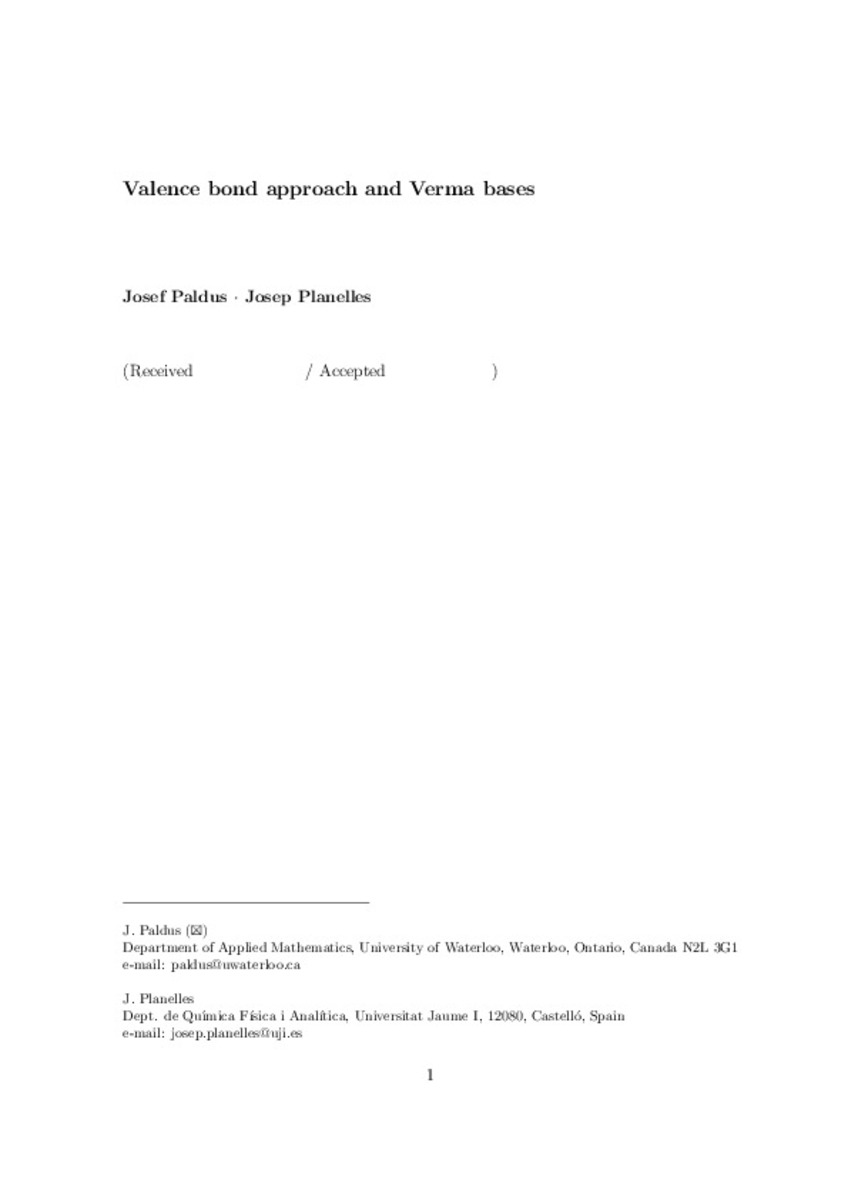Mostrar el registro sencillo del ítem
Valence bond approach and Verma bases
| dc.contributor.author | Paldus, Josef | |
| dc.contributor.author | Planelles, Josep | |
| dc.date.accessioned | 2018-05-11T10:49:42Z | |
| dc.date.available | 2018-05-11T10:49:42Z | |
| dc.date.issued | 2018-02 | |
| dc.identifier.citation | Paldus, J. & Planelles, J. J Math Chem (2018) 56: 1595. https://doi.org/10.1007/s10910-018-0876-7 | ca_CA |
| dc.identifier.uri | http://hdl.handle.net/10234/174634 | |
| dc.description.abstract | The unitary group approach (UGA) to the many-fermion problem is based on the Gel’fand–Tsetlin (G–T) representation theory of the unitary or general linear groups. It exploits the group chain U(n)⊃U(n−1)⊃⋯⊃U(2)⊃U(1) and the associated G–T triangular tableau labeling basis vectors of the relevant irreducible representations (irreps). The general G–T formalism can be drastically simplified in the many-electron case enabling an efficient exploitation in either configuration interaction (CI) or coupled cluster approaches to the molecular electronic structure. However, while the reliance on the G–T chain provides an excellent general formalism from the mathematical point of view, it has no specific physical significance and dictates a fixed Yamanouchi–Kotani coupling scheme, which in turn leads to a rather arbitrary linear combination of distinct components of the same multiplet with a given orbital occupancy. While this is of a minor importance in molecular orbital based CI approaches, it is very inconvenient when relying on the valence bond (VB) scheme, since the G–T states do not correspond to canonical Rumer structures. While this shortcoming can be avoided by relying on the Clifford algebra UGA formalism, which enables an exploitation of a more or less arbitrary coupling scheme, it is worthwhile to point out the suitability of the so-called Verma basis sets for the VB-type approaches. | ca_CA |
| dc.format.extent | 63 p. | ca_CA |
| dc.format.mimetype | application/pdf | ca_CA |
| dc.language.iso | eng | ca_CA |
| dc.publisher | Springer | ca_CA |
| dc.rights | © Springer International Publishing AG, part of Springer Nature 2018 | ca_CA |
| dc.rights.uri | http://rightsstatements.org/vocab/InC/1.0/ | * |
| dc.subject | Valence bond (VB) method | ca_CA |
| dc.subject | unitary group approach (UGA) | ca_CA |
| dc.subject | Verma bases | ca_CA |
| dc.subject | covalent and ionic VB structures | ca_CA |
| dc.subject | π-electron model | ca_CA |
| dc.subject | canonical versus non-canonical VB structures | ca_CA |
| dc.title | Valence bond approach and Verma bases | ca_CA |
| dc.type | info:eu-repo/semantics/article | ca_CA |
| dc.identifier.doi | https://doi.org/10.1007/s10910-018-0876-7 | |
| dc.rights.accessRights | info:eu-repo/semantics/openAccess | ca_CA |
| dc.relation.publisherVersion | https://link.springer.com/article/10.1007/s10910-018-0876-7#Abs1 | ca_CA |
| dc.date.embargoEndDate | 2019-02-01 | |
| dc.type.version | info:eu-repo/semantics/acceptedVersion | ca_CA |
Ficheros en el ítem
Este ítem aparece en la(s) siguiente(s) colección(ones)
-
QFA_Articles [813]
Articles de publicacions periòdiques







